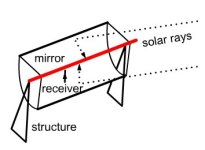Solar energy
Introduction
Solar energy comes from thermonuclear reactions that occur within the sun, causing the emission of high power electromagnetic radiation, appearing much like a “blackbody” at 5,800 K.
Outside the atmosphere, the radiation received by the Earth ranges, depending on the time of the year, between 1,350 and 1,450 W/m2. It is then partially reflected and absorbed by the atmosphere, so that the radiation received at ground level comprises a direct part and a diffuse part, the total ranging from 200 W/m2 (overcast) to about 1,000 W/m2 (zenith clear sky). The energy amount received by a given surface depends on climatic conditions of the place and its tilt and orientation. Atlases of solar radiation at the ground level are issued by national and international meteorological services in the form of maps and charts, on paper or digitally.
Section "Simulation of solar energy systems" in the "Methodological Guides" section provides you with methodologies for estimating solar resource.
Direct conversion of solar radiation is achieved in three main ways:
in the form of heat;
by photoelectric effect;
by photosynthesis.
The thermal conversion of solar energy consists in intercepting the incident photons on an absorbing material, whose temperature rises.
Several modes of capture are possible:
passive solar housing. For heating and space cooling applications, it is possible to design the architecture of the buildings so that they optimize naturally (or “passively”) the use of the solar resource, without using fluid flow and capture and storage auxiliary devices. The advantage of passive solar design of buildings is that it can lead to substantial energy savings with low incremental costs;
flat plate collectors generally use the greenhouse effect to minimize heat loss from the absorber. Indeed, glass is transparent to visible radiation, and therefore lets through the incident solar energy, but but also opaque to infrared radiation, which has the effect of trapping heat. According to the technology used, the operating temperatures of the flat plate vary from 40 °C to 120 °C (vacuum collectors). Figure below shows the sectional view of a collector. The absorber consists of a metal plate on which are welded pipes in which the thermal fluid circulates. Heat losses to the front of the collector are reduced by one or more glazings (2 on the figure) and those to the rear by an insulator;
concentration collectors. To reach temperatures above about 120 °C, it is necessary to concentrate the solar radiations by using suitable sets of reflective elements (mirrors) or lenses (usually Fresnel). The main constraint, apart from the higher cost of the devices, is the tracking system intended to follow the trajectory of the sun. A series of concentrators has been proposed and developed;
to thermodynamically convert solar radiation into electricity with a good efficiency, it is necessary to concentrate it, otherwise the heat losses of absorptive surfaces are very high and the collector effectiveness is too low. However, the costs of this industry and the technological difficulties encountered today limit its scope.

Concentration collectors
It is customary to characterize the concentration collectors by their concentration factor C, ratio of the surface of the collector and the one receiving the concentrated solar flux
The experience of the last thirty years shows that three main technologies are used in practice to achieve the concentration of solar radiation in technically and economically viable conditions:
parabolic troughs;
Fresnel lens concentrators;
parabolic dishes;
tower plants.
The first technologies only require to track the sun in one direction, but the concentration, and thus the collector temperature are lower (400 °C). The other two require a double tracking movement, but can reach much higher temperatures (750 - 1000 °C).
The parabolic trough or PT (C ≈ 40-80, Figure below) comprises cylinders parabolic in cross section, that concentrate sunlight onto a straight tube.

Fresnel linear concentrators or CLFR (C ≈ 30, Figure below) use narrow rectangular plane mirrors for concentrating sunlight onto an absorber consisting of a fixed number of parallel tubes.

In the parabolic dishes or PD (C ≈ 1,000-2,500, Figure below), the reflector is a paraboloid of revolution .

In the power towers or PT or central tower plants (C ≈ 200-700, Figure below), thousands of tracking reflectors, called heliostats, redirect incoming solar radiation to an absorber at the top of a tower, allowing to achieve both high concentrations and high radiation fluxes.

Photovoltaic electricity
Photovoltaic electricity is obtained thanks to doped semiconductors that, under the effect of the incident photons, produce a DC current, photon of sufficient energy h allowing electrons to jump an excitation level (see Figure below).

Originally developed to power satellites, solar cells are nowadays increasingly used for terrestrial applications, from solar calculators to high power generators.
Their main attraction is their simplicity of use: subject to direct or diffused sunlight, they produce electricity directly without moving parts, and require only simple maintenance.
The materials used to make them are mostly silicon, which, according to its crystalline state, leads to variable efficiencies (20% for the single crystal, 15% for the polycrystal, 8% for amorphous silicon, while the maximum theoretical efficiency is 43.5%). Other materials such as gallium arsenide are under study, and steady progress is being made year after year, foreshadowing significant improvements in performance in the short term.
Additional information
A guidance page for practical work explains the modeling of a SEGS solar power plant, and another one generation of electricity from a solar pond.
